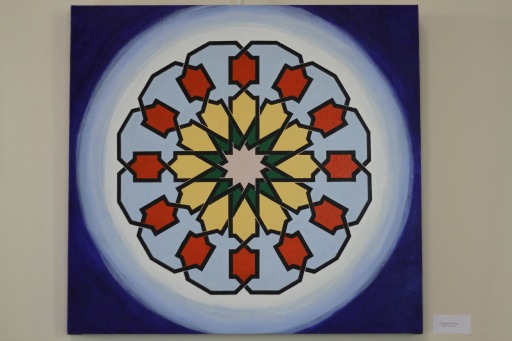
In a quiet museum tucked away in a small Maryland suburb, the Islamic art of local calligrapher Ahmed Belal and his daughter, Ayah, lines the halls of a museum founded more than thirty years ago to document the Quaker history of the area.
Surrounded by local artifacts from the town’s first Quaker school, Olney Inn, classical Khymer bangles and Kimball’s Market, the ornate verses and tight shots of the inside of mosques bring a new world to the local community in the exhibit, “With Pen and Camera.”
“You never get the chance to see this world so up close,” said Liz Kelley, an Olney resident. “It is simply pristine.”

On display until Sunday, November 23, 2014 at the Sandy Spring Museum, the exhibit is in partnership with the Islamic Society of the Washington Area, a masjid in Silver Spring, Md. Belal’s work fills the halls of many local mosques including the Muslim Community Center in Silver Spring and the Islamic Society of Baltimore. It has also graced the halls of churches and universities in the United States.
Born in Alexandria, Egypt, Belal began creating art since he was nearly 15 years old. Just as others studied flowers and attempting to recreate them in different shapes and forms, Belal says he studied the Quran and reconstructed its verses to expose their infinite beauty.
For Belal, his art is a form of worship. “My art is da’wah. I want others to see what Islam really is,” he says. Each piece - whether through boxy Kufic script, glittering tiles or carefully constructed geometric patterns - tells a different story.
His daughter paints with light and her purpose echoes her father’s. “Behind each shot is a tale waiting to be told,” she wrote in her artist’s statement. “I believe that the more we know about one another, the more peaceful we can become.”
Outside prayer halls and mosques, Belal and his daughter’s work meets an entirely different audience.
For Javier Gomez, the exhibit brings back a piece home. Originally from Spain, Gomez says the exhibit is a gift to society and reflects the rich knowledge and expression of Islamic culture.
“Muslims preserved Greek and Roman traditions,” he says. “I love the scientific tradition and how it is seen in art too.”
Unlike many methods used by contemporary artists, Belal’s work is authentic to its core. Each curve is calculated mathematically and a testament to a truly patient art.
The museum’s executive director Allison Weiss said she loved the idea of a father-daughter show and was intrigued by Ayah’s photos of the insides of mosques. Weiss also enjoyed the ornateness of the Islamic scripture.
“This is just our first effort to build bridges with the Muslim community,” Weiss said. “We want to play a role in bringing people of different backgrounds together.
Weiss hopes the exhibit allows viewers to see a local and international outlook and “open some doors to a broader understanding of people of different cultures,” she said. Non-Muslims should gain some insight into Muslim culture and Muslims should want to come back to the museum and engage with us on future projects, Weiss said.
The exhibit ends on this Sunday, November 23. To view more of Belal’s work, visit his website.









Comments powered by CComment